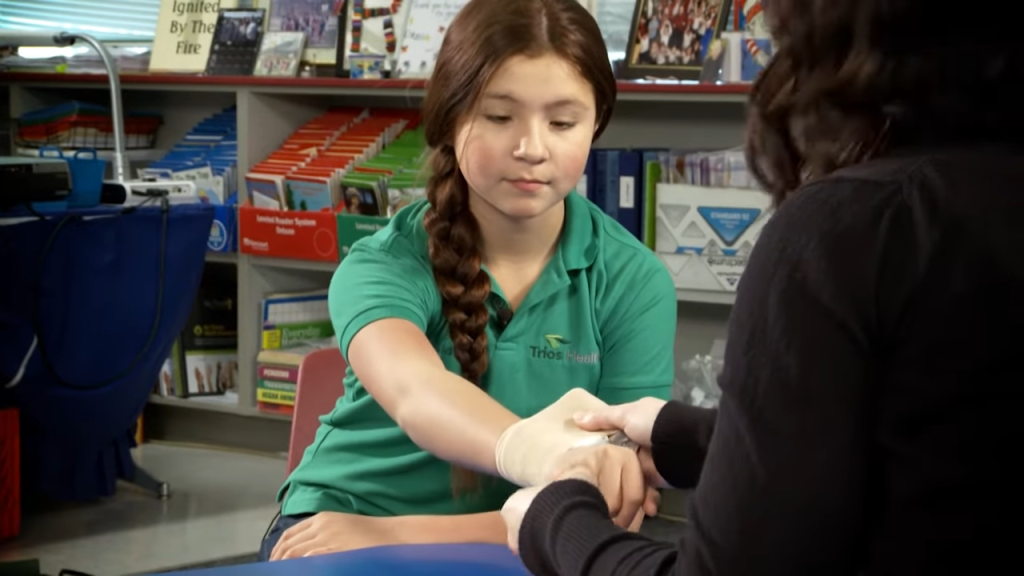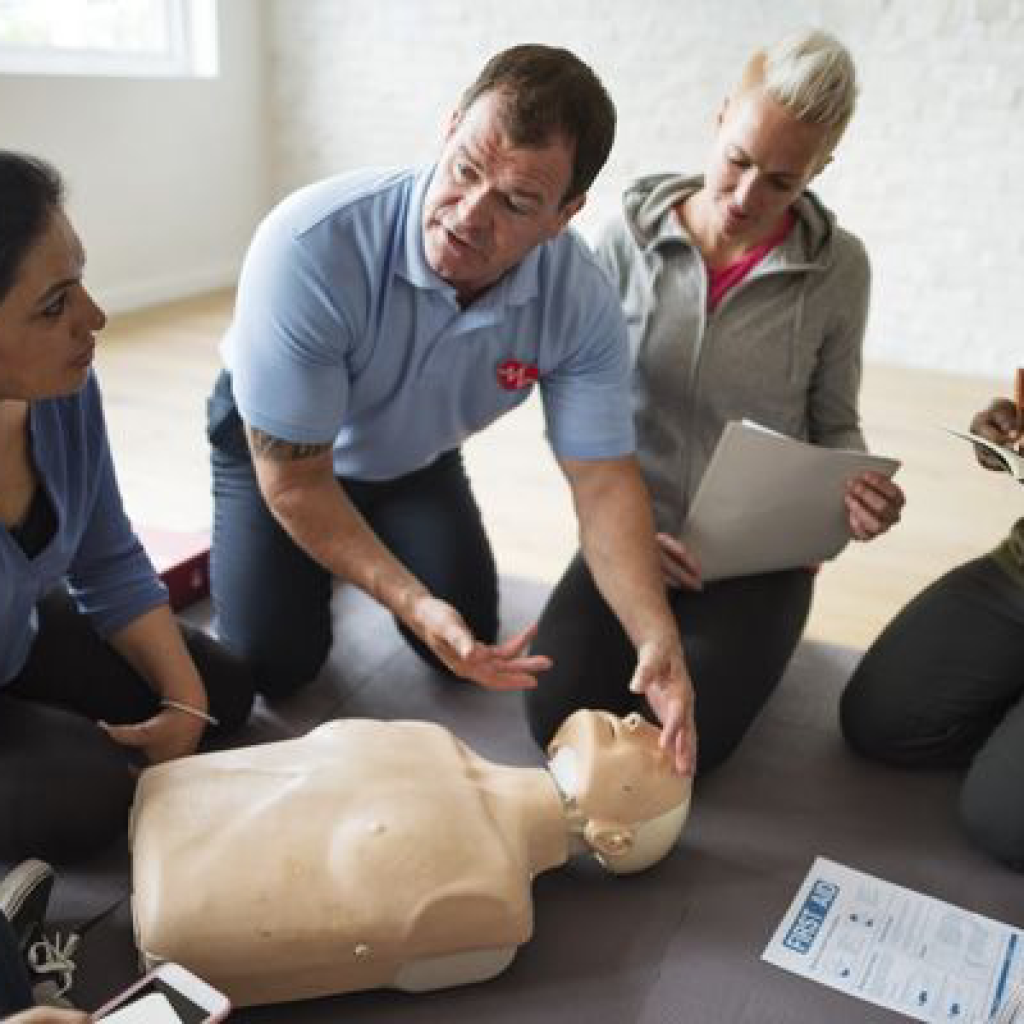Discover effective strategies for teaching basic first aid to 5-6 year old children.
Teaching Basic First Aid to 5-6 Year Old Children
Are you ready to embark on a journey of teaching basic first aid to 5-6 year old children? Well, buckle up and get ready for an adventure filled with excitement, learning, and a touch of playfulness! In this article, we will explore the importance of first aid for children, basic first aid skills suitable for this age group, teaching techniques to keep their little minds engaged, and how to overcome any challenges that may arise along the way. Let’s dive in!

Understanding the Importance of First Aid for Children
When it comes to the safety of our little ones, knowledge and preparedness are key. Teaching children basic first aid equips them with the skills they need to respond in an emergency situation and potentially save lives. But first aid is not just about immediate care – it also plays a crucial role in child safety. By teaching children about potential hazards and how to avoid accidents, we empower them to become safer and more confident individuals.
Imagine a world where every child knows how to handle a minor injury or react in a crisis. It would be a world where parents can have peace of mind, knowing that their children are equipped with the necessary skills to handle unexpected situations. First aid education for children is like giving them a superhero cape, protecting them from harm’s way.
The Role of First Aid in Child Safety
First aid is like a superhero cape for children, protecting them from harm’s way. By instilling basic first aid knowledge, we can teach them to identify potential dangers in their surroundings and take appropriate measures to avoid them. Whether it’s teaching them to look both ways before crossing the street or demonstrating proper handwashing techniques, first aid empowers children to make safe choices and prevent accidents before they happen.
Imagine a scenario where a child is playing near a swimming pool. With a solid foundation in first aid, that child would know the importance of water safety and understand the potential risks associated with unsupervised swimming. They would have the knowledge to recognize the signs of someone struggling in the water and take immediate action, potentially saving a life.
Benefits of Early First Aid Education
Early intervention is key, and when it comes to first aid education, starting young has numerous benefits. By introducing first aid concepts at a young age, children are more likely to retain the information and develop a lifelong understanding of emergency preparedness. Additionally, learning first aid enhances their cognitive skills, boosts their problem-solving abilities, and nurtures a sense of empathy and compassion towards others. Plus, who knows, you might inspire a future doctor or nurse!
Imagine a classroom filled with enthusiastic children, eager to learn about first aid. As they absorb the knowledge and practice their skills, they not only become more capable of handling emergencies but also develop a sense of responsibility and confidence. They gain the ability to assess a situation, think critically, and take appropriate action, whether it’s applying a bandage to a scraped knee or calling for help in a more serious situation.
Moreover, first aid education for children can have a ripple effect. As these young individuals grow up, they become advocates for safety within their communities. They share their knowledge with friends, family, and even strangers, spreading awareness and potentially saving even more lives.
Basic First Aid Skills Suitable for 5-6 Year Olds
Now that we understand the importance of first aid for children, let’s dive into some basic skills that are perfect for 5-6 year olds. Remember, the goal here is to keep it simple, engaging, and age-appropriate.
Recognizing an Emergency Situation
One of the first skills we can teach our little ones is how to recognize an emergency situation. We can use interactive demonstrations and stories to explain what constitutes an emergency and when to seek help. For example, we can tell them about the importance of recognizing signs like someone who is unconscious, not breathing, or bleeding heavily. By playing games that involve identifying potential dangers or role-playing scenarios, we can encourage them to be alert and attentive. This will help them develop the ability to assess situations and determine if they need to seek help.
Let’s imagine a scenario where a child is playing in the park and sees someone fall off a swing and not get up. By teaching our little ones to recognize this as an emergency situation, they can quickly understand the need to seek help. We can explain that they should find an adult nearby, such as a parent or a park supervisor, and inform them about what happened. This way, they can actively contribute to ensuring the safety and well-being of others.
Calling for Help
Knowing how to call for help is a vital skill. Teach children how to dial emergency numbers, such as 911, and practice using a toy phone or a pretend emergency call game. Emphasize the importance of providing clear and concise information to the dispatcher and explain the role of emergency services in helping those in need.
Let’s imagine another scenario where a child is at home and witnesses a family member experiencing a medical emergency. By teaching them how to call for help, they can play a crucial role in getting the necessary assistance. We can explain that they should remain calm and dial the emergency number, clearly stating their name, address, and the nature of the emergency. This way, they can effectively communicate the situation to the dispatcher and ensure that help arrives as quickly as possible.
Simple Wound Care
Learning how to take care of minor cuts and scrapes is another valuable skill for our little first aid superheroes. Show them how to clean a wound with soap and water, apply a bandage, and explain the importance of keeping wounds clean to prevent infections. Using colorful band-aids and letting them practice on dolls or stuffed animals can make the learning process fun and engaging.
Let’s imagine yet another scenario where a child is playing with friends and one of them falls and gets a small cut on their knee. By teaching our little ones how to provide simple wound care, they can assist their friends in times of need. We can explain that they should first help their friend sit down and then gently clean the wound with soap and water. After that, they can apply a colorful band-aid to protect the wound and prevent any dirt or germs from entering. By involving them in the process and making it interactive, they can develop the confidence and skills necessary to help others.
Remember, these are just a few examples of the basic first aid skills that are suitable for 5-6 year olds. By teaching our little ones these skills, we are empowering them to be proactive in emergency situations and potentially save lives. Let’s continue to nurture their curiosity and desire to learn, ensuring that they grow up to be responsible and compassionate individuals who are always ready to lend a helping hand.
Teaching Techniques for First Aid Education
Now that we’ve explored some basic first aid skills suitable for 5-6 year olds, let’s dive into effective teaching techniques to make the learning experience enjoyable and memorable.

Using Age-Appropriate Language
Children at this age are bursting with curiosity and imagination, so it’s essential to tailor our language to their level of understanding. Use simple and descriptive words to explain concepts, and encourage them to ask questions. Incorporate engaging visuals, such as colorful diagrams or interactive videos, to capture their attention and make the learning process more vibrant.
For example, when teaching them about the importance of applying pressure to stop bleeding, you can explain it as giving a big bear hug to the injured area. This playful analogy helps them understand the concept of applying pressure without overwhelming them with medical jargon.
Moreover, encourage them to share their own experiences or stories related to first aid. This not only makes the learning experience more interactive but also helps them relate the skills they are learning to real-life situations.
Incorporating Play in Learning
Play is not only fun but also a powerful educational tool. Create interactive games and activities that simulate real-life emergency situations. For example, you can set up an obstacle course where children have to navigate through different safety hazards, promoting hands-on learning while having a blast.
Another engaging activity is to organize a “first aid treasure hunt.” Hide various first aid items around the learning area and provide the children with clues to find them. This not only encourages them to explore and learn about different first aid supplies but also enhances their problem-solving skills.
Incorporate role-playing exercises and let them take turns acting as both the rescuer and the person in need. This allows them to practice their first aid skills in a safe and controlled environment while also developing empathy and teamwork.
Reinforcing Lessons Through Repetition
Repetition is the key to mastery, and this holds true for teaching first aid as well. Continuously reinforce the skills and knowledge they’ve acquired by revisiting previous lessons in a fun and engaging manner.
One effective way to reinforce lessons is through regular quizzes. Create interactive quizzes with multiple-choice questions or true/false statements. This not only helps them recall information but also adds an element of friendly competition among the children.
Hands-on demonstrations are also a great way to reinforce learning. For example, when teaching them how to perform CPR, provide them with mannequins or dolls to practice on. This hands-on experience helps them develop muscle memory and confidence in their abilities.
Additionally, consider implementing a reward system to motivate the children to remember and apply what they’ve learned. For every correct answer or successful demonstration, they can earn small rewards such as stickers or certificates. This positive reinforcement encourages them to actively participate and engage in the learning process.
Overcoming Challenges in Teaching First Aid to Young Children
Teaching first aid to young children can present unique challenges, but with the right approach, you can conquer them like a pro!
Addressing Children’s Fears
It’s natural for children to have fears or anxieties around accidents or emergency situations. Approach these concerns with empathy and reassurance. Create a safe and supportive environment where they feel comfortable expressing their worries. Through open communication and gentle guidance, we can help alleviate their fears and build their confidence in handling emergencies.
Ensuring Understanding and Retention
Children learn best through repetition and hands-on experiences. To ensure understanding and retention, offer plenty of opportunities for practical application of the skills they’ve learned. Encourage them to practice first aid techniques with family members or friends, and keep the learning alive by incorporating first aid reminders into their daily routines.
Dealing with Misconceptions
Children may develop misconceptions or misunderstandings around first aid concepts. Take the time to address these misconceptions through open dialogue and gentle corrections. Encourage them to ask questions and provide accurate and age-appropriate explanations to ensure their understanding is clear.
Teaching basic first aid to 5-6 year old children is an incredibly rewarding experience. By imparting these life-saving skills at an early age, we are shaping a generation of confident and safety-conscious individuals. So, let’s put our capes on, dive into the adventure of first aid education, and empower our little superheroes to make a difference!



